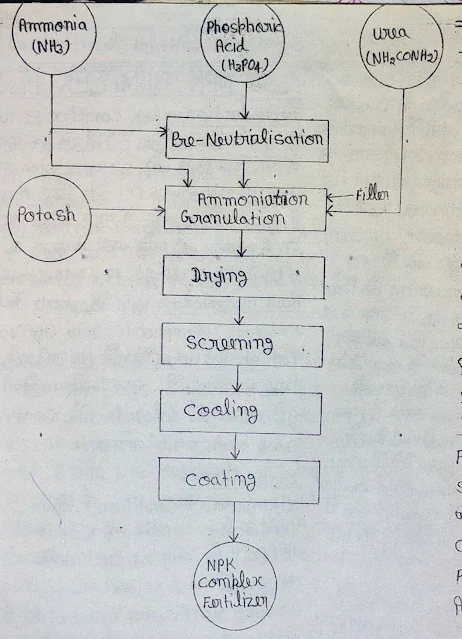The NPK Fertilizer consists of solid fertilizers as a similar, which are directed by normal 3 chemicals. The first chemical Nitrogen (N), the second phosphorous (p) and third potassium (k) are. These fertilizers are very convenient to use. Different grades that are produced in India are as follows. 17-17-17, 10-32-16, 14-35-14.
{tocify} $title={Table of Contents}
RAW Materials used in making NPK
NPK is required to produce fertilizer in RAW Materials in Phosphoric Acid, Ammonia, and Potash or Urea. Which is necessary to increase the amount of nitrogen. Supplements for certain fertilizers (Sand, Dolomite, and Coating Agent, Clay Soap Stone) are also used.
NPK Construction Process
Ammonia and phosphoric acids do feed in the pre-neutrilizer in the required proportion and move the slurry from here to rotary Drum Type Granulator by Pump. Here are some ammonia and urea feed to increse to the nitrogen content.
Potash and Filler also add into Ammoniation Grannulator. The Mixture received from here occurs, which remove the moisture by sending moisture to dryer, then Screening Cooling and coating after the action of NPK Complex Fertilizer products are received.
NPK Handling, Storage and Packing
NPK complex fertilizer freely flows. Therefore there is no problem in its storage and handling. But there can be more cake forest from keeping more moisture ina. That's why NPK Complex Fertilizer Polyethylene Lined HDPE Bags are packed. There can not be a little moisture from the atmosphere.
Types of NPK (NPK) Fertilizers
In NPK fertilizers, the face is classified based on the amount of three nutrients.
1. Balanced fertilizer
These fertilizers have the same amount of three nutrients (nitrogen, phosphorus and potassium). These are the common purpose fertilizers, which can be used on various types of plants. Examples of balanced fertilizers are 10-10-10 and 15-15-15.
2. High nitrogen fertilizer
This type of fertilizers have high amounts of nitrogen, which helps in promoting the development of the leaf. They are essential for fast growing plants such as green leafy vegetables and lawn grass. Examples of 24-8-16 and 32-10-5 high nitrogen fertilizers.
3. High phosphorus fertilizer
Fertilizers having high amounts of phosphorus in fertilizers are called high phosphorus fertilizers, which helps to increase root growth and the production of flowers and fruits. 10-20-10 and 6-24-24 are examples of high phosphorus fertilizers.
4. High potassium fertilizer
These fertilizers have high amounts of potassium, which helps in promoting strong roots and stems. These fruits and vegetables are essential for flowering plants. 0-10-10 and 4-8-15 are examples of high potassium fertilizers.

